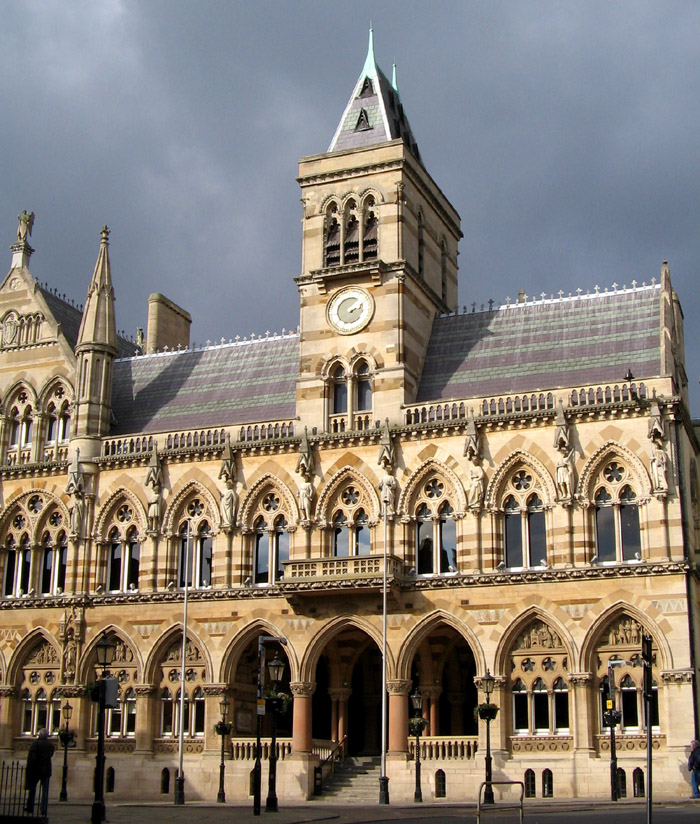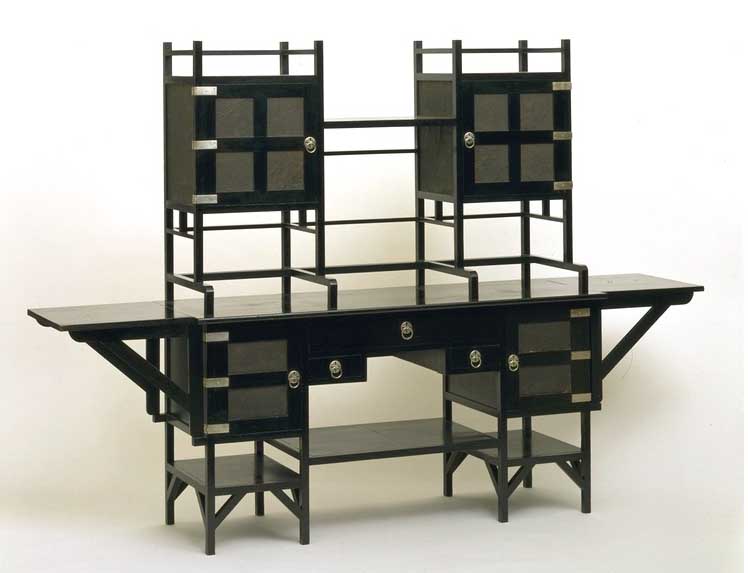|
Edward William Godwin
Edward William Godwin (26 May 1833 – 6 October 1886) was a progressive English architect-designer, who began his career working in the strongly polychromatic "John Ruskin, Ruskinian Gothic" style of mid-Victorian Britain, inspired by ''The Stones of Venice (book), The Stones of Venice'', then moved on to provide designs in the "Anglo-Japanese taste" of the Aesthetic movement in the 1870s, after coming into contact with Japanese culture in the 1862 International Exhibition in London. Godwin's influence can be detected in the later Arts and Crafts movement. His best known early works include Northampton Guildhall, The Guild Hall, Northampton, which was his first notable public commission, and Congleton Town Hall, as well as restorations and Gothic revival, neo-Gothic additions to Dromore Castle (County Limerick), Dromore Castle, Limerick and Castle Ashby. Biography Apprenticed to an engineer in Bristol, where his architectural training was largely self-taught, Godwin moved ... [...More Info...] [...Related Items...] OR: [Wikipedia] [Google] [Baidu] |
Bristol
Bristol () is a City status in the United Kingdom, cathedral city, unitary authority area and ceremonial county in South West England, the most populous city in the region. Built around the River Avon, Bristol, River Avon, it is bordered by the ceremonial counties of Gloucestershire to the north and Somerset to the south. The county is in the West of England combined authority area, which includes the Greater Bristol area (List of urban areas in the United Kingdom, eleventh most populous urban area in the United Kingdom) and nearby places such as Bath, Somerset, Bath. Bristol is the second largest city in Southern England, after the capital London. Iron Age hillforts and Roman villas were built near the confluence of the rivers River Frome, Bristol, Frome and Avon. Bristol received a royal charter in 1155 and was historic counties of England, historically divided between Gloucestershire and Somerset until 1373 when it became a county corporate. From the 13th to the 18th centur ... [...More Info...] [...Related Items...] OR: [Wikipedia] [Google] [Baidu] |
Gothic Revival Architecture
Gothic Revival (also referred to as Victorian Gothic or neo-Gothic) is an Architectural style, architectural movement that after a gradual build-up beginning in the second half of the 17th century became a widespread movement in the first half of the 19th century, mostly in England. Increasingly serious and learned admirers sought to revive medieval Gothic architecture, intending to complement or even supersede the Neoclassical architecture, neoclassical styles prevalent at the time. Gothic Revival draws upon features of medieval examples, including decorative patterns, finials, lancet windows, and hood moulds. By the middle of the 19th century, Gothic Revival had become the pre-eminent architectural style in the Western world, only to begin to fall out of fashion in the 1880s and early 1890s. For some in England, the Gothic Revival movement had roots that were intertwined with philosophical movements associated with Catholicism and a re-awakening of high church or Anglo-Cathol ... [...More Info...] [...Related Items...] OR: [Wikipedia] [Google] [Baidu] |
Liberty (department Store)
Liberty, commonly known as Liberty's, is a luxury department store in London, England. It is located on Great Marlborough Street in the West End of London. The building spans from Carnaby Street in the East to Kingly Street in the West, where it forms a three storey archway over the Northern entrance to the Kingly Street mall that houses the Liberty Clock in its centre. Liberty is known around the world for its close connection to art and culture, but it is most famous for its bold and floral print fabrics. The vast mock-Tudor store also sells men's, women's and children's fashion, beauty and homewares from a mix of high-end and emerging brands and labels. The store is known to spot and champion young designers at the start of their careers, and many now-prominent brands were first available at Liberty. The store played essential role in spreading and popularizing the Modern Style (British Art Nouveau style), Modern Style. This continues Liberty's long reputation for working wi ... [...More Info...] [...Related Items...] OR: [Wikipedia] [Google] [Baidu] |
Museum Of Modern Art
The Museum of Modern Art (MoMA) is an art museum located in Midtown Manhattan, New York City, on 53rd Street (Manhattan), 53rd Street between Fifth Avenue, Fifth and Sixth Avenues. MoMA's collection spans the late 19th century to the present, and includes over 200,000 works of architecture and design, drawing, painting, sculpture, photography, screen printing, prints, book illustration, illustrated and artist's books, film, as well as electronic media. The institution was conceived in 1929 by Abby Aldrich Rockefeller, Lillie P. Bliss, and Mary Quinn Sullivan. Initially located in the Crown Building (Manhattan), Heckscher Building on Fifth Avenue, it opened just days after the Wall Street Crash of 1929, Wall Street Crash. The museum was led by Anson Goodyear, A. Conger Goodyear as president and Abby Rockefeller as treasurer, with Alfred H. Barr Jr., Alfred H. Barr Jr. as its first director. Under Barr's leadership, the museum's collection rapidly expanded, beginning with an inaug ... [...More Info...] [...Related Items...] OR: [Wikipedia] [Google] [Baidu] |
Collinson & Lock
Collinson is a surname. Notable people with the surname include: * Angel Collinson (born 1990), American former professional free and big mountain skier * Cliff Collinson (1920–1990), English footballer * Fred Collinson (1874–1915), English footballer and soldier * Geoff Collinson, Australian horn player and Head of Brass at the University of Melbourne * Harry Collinson Owen (1882–1956), British journalist and author * James Collinson (1825–1881), Victorian painter who was a member of the Pre-Raphaelite Brotherhood * John Collinson (cricketer) (1911–1979), English cricketer * John Collinson (historian) (c.1757–1793), English cleric and historian of Somerset * Laurence Collinson (1925–1986), British and Australian playwright, actor, poet, journalist, and secondary school teacher * Les Collinson (born 1935), English professional footballer * Lucy Collinson, English scientist * Madeleine Collinson (1952–2014), Maltese-British model and actress; twin of Mary Co ... [...More Info...] [...Related Items...] OR: [Wikipedia] [Google] [Baidu] |
Sideboard (Edward William Godwin)
This sideboard was designed by Edward William Godwin (1833–1886), who was one of the most important exponents of Victorian ''Japonisme'' or Anglo-Japanese style, the appropriation of Japanese artistic styles. Japan began trading with the West in the 1850s, and by the next decade imported Japanese ''ukiyo-e'' prints, Japanese ceramics and textiles were very fashionable in Britain. Godwin was influenced by interiors depicted in Japanese prints and by the studies he made of Japanese architecture, but he did not seek to imitate Japanese designs. Instead his Anglo-Japanese furniture aimed to combine the more general principles of simplicity and elegance he admired in the art of Japan with domestic needs of the Victorian home. The sideboard is stylish and dramatic, but it is also quite appropriate for use in a dining room. It is functional with drawers, adjustable shelves, and a rack fitted to take a large dish between the cupboards. The construction and finish are practical and ... [...More Info...] [...Related Items...] OR: [Wikipedia] [Google] [Baidu] |
Anglo-Japanese Style
The Anglo-Japanese style developed in the United Kingdom through the Victorian era and early Edwardian era from approximately 1851 to the 1910s, when a new appreciation for Japanese aesthetics, Japanese design and Culture of Japan, culture influenced how designers and craftspeople made British art, especially the decorative arts and architecture of England, covering a vast array of art objects including ceramics, furniture and interior design. Important centres for design included London and Glasgow. The style was part of the wider European movement known as Japonisme. The first use of the term "Anglo-Japanese" occurs in 1851, and developed due to the keen interest in Japan, which due to Sakoku, Japanese state policy until the 1860s, had been closed to the Western markets. The style was popularised by Edward William Godwin in the 1870s in England, with many artisans working in the style drawing upon Japan as a source of inspiration and designed pieces based on Japanese Art, whils ... [...More Info...] [...Related Items...] OR: [Wikipedia] [Google] [Baidu] |
Eclecticism
Eclecticism is a conceptual approach that does not hold rigidly to a single paradigm or set of assumptions, but instead draws upon multiple theories, styles, or ideas to gain complementary insights into a subject, or applies different theories in particular cases. However, this is often without conventions or rules dictating how or which theories were combined. Eclecticism in ethics, philosophy, politics, and religion is often compared to syncretism, but the two concepts differ in their approach to combining elements from different traditions. While syncretism in religion involves the merging or assimilation of several distinct traditions into a new, unified system, eclecticism adopts elements from various systems without necessarily integrating them into a single cohesive framework. This distinction allows for a broader, more inclusive approach in eclecticism, where the selection is based on individual merit or preference rather than an attempt to create a new unified tradition ... [...More Info...] [...Related Items...] OR: [Wikipedia] [Google] [Baidu] |
Victoria And Albert Museum
The Victoria and Albert Museum (abbreviated V&A) in London is the world's largest museum of applied arts, decorative arts and design, housing a permanent collection of over 2.8 million objects. It was founded in 1852 and named after Queen Victoria and Albert, Prince Consort, Prince Albert. The V&A is in the Royal Borough of Kensington and Chelsea, in an area known as "Albertopolis" because of its association with Prince Albert, the Albert Memorial, and the major cultural institutions with which he was associated. These include the Natural History Museum, London, Natural History Museum, the Science Museum (London), Science Museum, the Royal Albert Hall and Imperial College London. The museum is a non-departmental public body sponsored by the Department for Digital, Culture, Media and Sport. As with other national British museums, entrance is free. The V&A covers and 145 galleries. Its collection spans 5,000 years of art, from ancient history to the present day, from the c ... [...More Info...] [...Related Items...] OR: [Wikipedia] [Google] [Baidu] |
James Abbott McNeill Whistler
James Abbott McNeill Whistler (; July 10, 1834July 17, 1903) was an American painter in oils and watercolor, and printmaker, active during the American Gilded Age and based primarily in the United Kingdom. He eschewed sentimentality and moral allusion in painting and was a leading proponent of the credo "art for art's sake". His signature for his paintings took the shape of a stylized butterfly with an added long stinger for a tail. The symbol combined both aspects of his personality: his art is marked by a subtle delicacy, while his public persona was combative. He found a parallel between painting and music, and entitled many of his paintings "arrangements", "harmonies", and Nocturne (painting), "nocturnes", emphasizing the primacy of tonal harmony. His most famous painting, ''Arrangement in Grey and Black No. 1'' (1871), commonly known as ''Whistler's Mother'', is a revered and often parodied portrait of motherhood. Whistler influenced the art world and the broader culture of ... [...More Info...] [...Related Items...] OR: [Wikipedia] [Google] [Baidu] |
Beatrice Whistler
Beatrice Whistler (also known as Beatrix or Trixie; 12 May 1857 – 10 May 1896) was born in Chelsea, London on 12 May 1857. She was the eldest daughter of ten children of the sculptor John Birnie Philip and Frances Black. She studied art in her father's studio and with Edward William Godwin who was an architect-designer. On 4 January 1876 she became the second wife of Edward Godwin. Following the death of Godwin, Beatrice married James McNeill Whistler on 11 August 1888. Family Edward Godwin and Beatrice had a son together, also called Edward (1876–1957), who became known as a sculptor. He created the bronze angels that were placed on the Whistlers' tomb in Chiswick Old Cemetery. Her sister Ethel Whibley had been the secretary to Whistler before her marriage to the writer Charles Whibley. After the death of Beatrice in 1896, her younger sister Rosalind Birnie Philip acted as secretary to Whistler and was appointed Whistler's executor, executrix in his will. In Whistler's ... [...More Info...] [...Related Items...] OR: [Wikipedia] [Google] [Baidu] |








